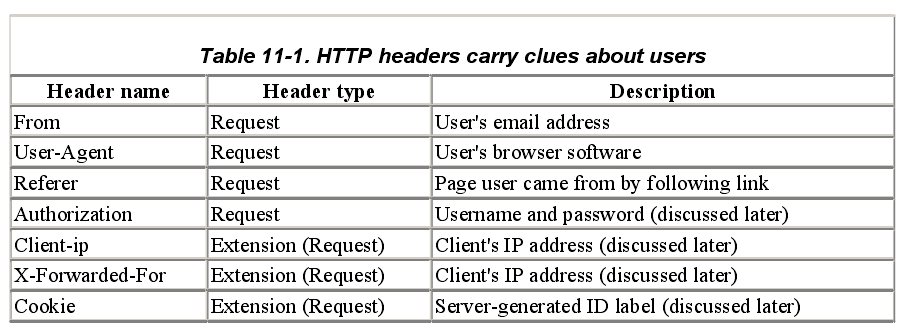用户信息通过HTTP头部承载:不能实现用户唯一性标识。
w
HTTP The Definitive Guide
Table 11-1 shows the seven HTTP request headers that most commonly carry information about the
user. We'll discuss the first three now; the last four headers are used for more advanced identification
techniques that we'll discuss later.

The From header contains the user's email address. Ideally, this would be a viable source of user
identification, because each user would have a different email address. However, few browsers send From headers, due to worries of unscrupulous servers collecting email addresses and using them for
junk mail distribution. In practice, From headers are sent by automated robots or spiders so that if
something goes astray, a webmaster has someplace to send angry email complaints.
The User-Agent header tells the server information about the browser the user is using, including the
name and version of the program, and often information about the operating system. This sometimes
is useful for customizing content to interoperate well with particular browsers and their attributes, but
that doesn't do much to help identify the particular user in any meaningful way. Here are two User-
Agent headers, one sent by Netscape Navigator and the other by Microsoft Internet Explorer:
Navigator 6.2
User-Agent: Mozilla/5.0 (Windows; U; Windows NT 5.0; en-
US; rv:0.9.4) Gecko/20011128
Netscape6/6.2.1
Internet Explorer 6.01
User-Agent: Mozilla/4.0 (compatible; MSIE 6.0; Windows NT
5.0)
The Referer header provides the URL of the page the user is coming from. The Referer header alone
does not directly identify the user, but it does tell what page the user previously visited. You can use
this to better understand user browsing behavior and user interests. For example, if you arrive at a web
server coming from a baseball site, the server may infer you are a baseball fan.
The From, User-Agent, and Referer headers are insufficient for dependable identification purposes.
The remaining sections discuss more precise schemes to identify particular users.